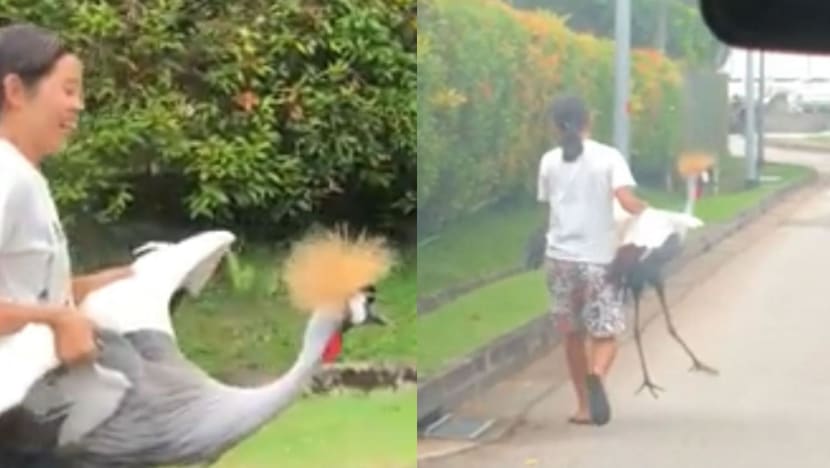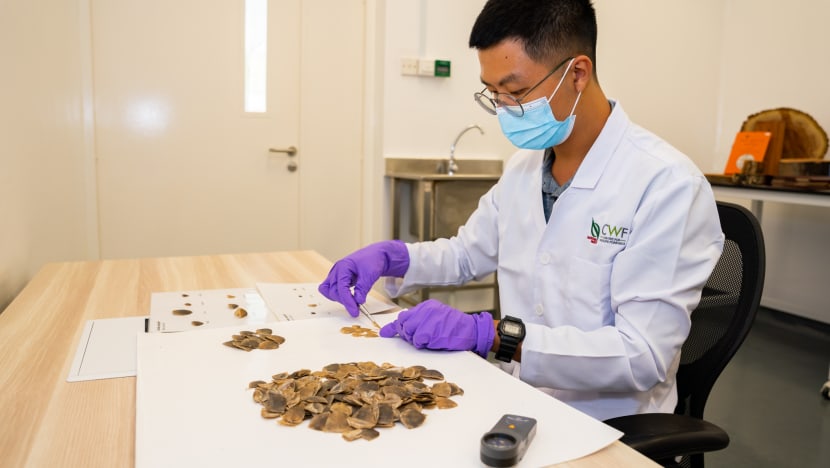Commentary: Exotic pets turn heads, but should you get one?
It is highly challenging to meet a wild animal’s needs and natural behaviours in a home, even more so in our predominantly urban high-rise environment, says SPCA’s Aarthi Sankar.

Videos on social media showed a woman carrying a grey crowned crane by its wings. (Screengrab: Reddit/Chaosli0n)
SINGAPORE: Videos of a grey crowned crane escaping from a home made the rounds on social media in April, piquing much public interest in the majestic, endangered bird.
While the owner says the bird is licensed, it brings to mind other viral clips of otters, hedgehogs, slow lorises and more being kept as pets. Such images and videos have ballooned in popularity over recent years, with Instagram accounts and YouTube videos dedicated to showcasing the domestic lives of these exotic animals.
While most people are content with the companionship of a dog, cat, hamster or rabbit, there are those who prefer the idea of keeping an exotic pet because of the perceived novelty and challenges of rearing a rare animal.
In Singapore, government regulations prohibit keeping many species of wild animals as pets. The Wildlife Act, however, allows for the keeping of certain exotic animals where risks to public safety and health are considerably lower.
These include red-eared terrapins, American bullfrogs and birds (excluding crows, pigeons, mynahs and protected wildlife species) among others. Ownership of these animals is regulated and must be accompanied by a CITES (Convention on International Trade in Endangered Species of Wild Fauna and Flora) permit.
Regulations aside, one question remains – even if it were legal to own an exotic animal, does that mean you should?
MISCONCEPTIONS ABOUT EXOTIC ANIMALS AND THEIR CONSEQUENCES
Caring for pets generally, is a tremendous responsibility requiring a lifetime of commitment. It is essential to be armed with as much information as possible in relation to any pet’s needs so that you can provide it with a comfortable life.
While our understanding of our natural environment and wildlife has increased with progress in science and media, there is still a lot we do not know about exotic animals and their lifestyles.
There are also common misconceptions that some exotic animals are resilient and easy to care for.
Many parents assume red-eared terrapins are low-maintenance and therefore low-commitment, purchasing them to teach children about responsibility before getting a “real” pet. The reality is quite the opposite because the terrapins can live for more than 20 years.
As a result, Society for the Prevention of Cruelty to Animals (SPCA) Singapore has seen red-eared terrapins living uncomfortably in tanks they’ve outgrown, then abandoned in unfamiliar environments once caring for them becomes difficult.
It’s unlikely that education at the point of sale alone can clear such misconceptions. Even with the abundant information available on caring for cats and dogs, we still see over 300 cases of alleged neglect, compromised welfare and cruelty yearly – and these are just reported cases.THE SPECIAL NEEDS OF EXOTIC ANIMALS
Exotic animals have complex special needs that are imperative for them to thrive. These could range from mixed diets that can only be sourced and foraged in the wild to controlled temperatures and humidity levels. Some reptiles require UV lighting when direct sunlight is not available.
While greater access to information and a wider range of products online have enabled us to mimic their lifestyles in the wild, it is not possible for us to match their diets or living conditions exactly.
Some owners don’t put effort into replicating their natural habitats too. We’ve seen cases of peacocks living their entire lives in small enclosures with little access to water.
It might not be sustainable for owners to continue providing their exotic pets with specialised care for their entire lifespans – which in some instances can be longer than human lifespans.
Veterinary care is also an important factor for these pets’ well-being. Not all vets may be equipped or prepared to provide care for exotic animals since they do not see such cases regularly.
Then there are the daily logistical challenges too. It isn’t easy to confine and ensure an exotic animal does not escape a home – just like the pet grey crowned crane. Given that some of these animals are highly active at night, keeping them confined could lead to excessive noise, possibly causing disputes between neighbours.
More serious is the risk of exotic animals behaving unpredictably. Even after years of domestication, it is possible for an animal to have a sudden change in temperament which could endanger the owner.
Likewise, most people don’t know enough about these animals to behave or react appropriately when in close contact. On May 8 in Selangor, Malaysia, a man, who was helping a friend care for his exotic snakes, was killed after getting bitten by a puff adder. The highly venomous snake native to Africa is reportedly on the loose.
A TICKING ANIMAL WELFARE TIME BOMB
It’s true that there are committed owners out there who are willing to pour time and money into caring for their exotic pets.
But the bottom line is that a wild animal’s needs and natural behaviours cannot be met in a home, even more so in our predominantly urban high-rise environment. Wild animals ultimately belong in the wild.
Moreover, the purchase of exotic animals, while legal, could inadvertently support a much larger and lucrative wildlife trade. The US$23 billion (S$31.7 billion) industry is one of the key drivers of global wildlife decline.
The United Nations’ World Wildlife Crime Report 2020 said over 6,000 fauna and flora species were seized over the past two decades, with the trafficking of pangolins increasing tenfold between 2014 to 2018.
Singapore remains a key transit hub for wildlife traders across Southeast Asia. Authorities regularly confiscate live animals meant for sale and intercept shipments of illegal products such as pangolin scales and elephant ivory.
Globally, we have seen how legalising exotic animals as pets has compromised animal welfare.
RSPCA reported rescuing 4,000 exotic pets across England and Wales in 2018, with the charity’s hotline receiving over 15,000 calls over cases of neglect or escaped pets.
In September 2021, RSPCA and Born Free Foundation warned of the animal welfare “ticking time bomb” due to the extensive trading and keeping of wild animals as pets in UK households, which tally at an estimated 1.8 million reptiles, amphibians and invertebrates,1.3 million indoor birds, and more than 100 million ornamental fish.
No matter how much money or time you have, more often than not, you won’t be able to meet the diverse and unique requirements needed for an exotic pet’s well-being.
If you truly believe you have the expertise and resources to care for an exotic animal, consider re-homing an animal that can no longer be released back into the wild, instead of purchasing.
If it is wildlife and advocacy efforts that you are passionate about, consider volunteering with local groups such as ACRES so that you can contribute to their meaningful work and keep our wildlife safe where they belong.
Aarthi Sankar is the Executive Director of SPCA Singapore.


















